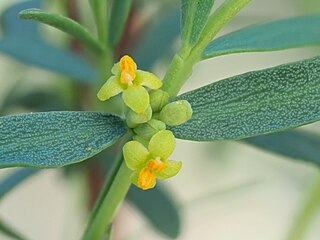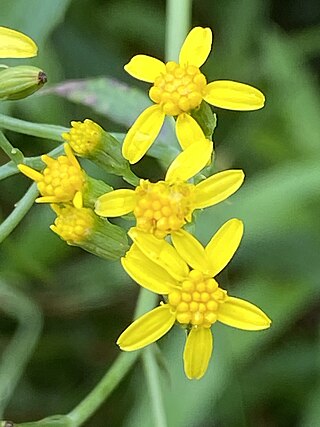
Mentha diemenica, commonly known as slender mint, is a flowering plant in the Lamiaceae family. It grows in the Northern Territory, Australian Capital Territory and all mainland states except Western Australia. It has mint-scented foliage and clusters of purple flowers.

Acrotriche depressa, commonly known as wiry ground-berry or honeypots, is a flowering plant in the family Ericaceae. It is a small shrub with crowded greyish-green leaves and white or green flowers and grows in southern Australia.

Olearia ramulosa, commonly known as twiggy daisy-bush, is a species of flowering plant in the family Asteraceae and is endemic to south-eastern Australia. It is a shrub with narrowly elliptic, linear or narrowly egg-shaped leaves, and pale blue, mauve or white and yellow, daisy-like inflorescences.

Olearia phlogopappa commonly known as the dusty daisy-bush or alpine daisy-bush is a species of flowering plant in the family Asteraceae that is commonly found in eastern New South Wales, Victoria and Tasmania. It is a small shrub with greyish-green foliage, daisy-like flowers in white, pink or mauve that can be seen from spring to late summer.

Hovea montana, commonly known as alpine hovea, mountain hovea or alpine rusty-pods, is a flowering plant in the family Fabaceae, and is endemic to Australia. It is a small shrub with narrow leaves and purple pea flowers.

Scaevola albida, commonly known as pale fan-flower or small-fruit fan-flower, is a flowering plant in the family Goodeniaceae. It is a spreading perennial herb with pale blue or white fan-shaped flowers and obovate leaves. It grows in Queensland through eastern New South Wales and coastal areas of Victoria and Tasmania.

Stackhousia monogyna, commonly known as creamy stackhousia or creamy candles,is a flowering plant in the family Celastraceae. It is a small multi-stemmed plant with narrow leaves and terminal spikes of white, cream or yellow flowers. It is a widespread species found in all states of Australia but not the Northern Territory.

Olearia asterotricha, commonly known as rough daisy-bush, is a species of flowering plant in the family Asteraceae. A tall shrub with white, mauve or blue daisy like flowers growing from the Blue Mountains in New South Wales to western Victoria, Australia.

Olearia myrsinoides, commonly known as silky daisy-bush or blush daisy bush, is a species of flowering plant in the family Asteraceae and is endemic to south-eastern Australia. It is a spreading shrub with hairy branchlets, egg-shaped to elliptic leaves with toothed edges, and white and yellow or mauve, daisy-like inflorescences.

Pimelea pauciflora, commonly known as poison rice-flower, is a species of shrub in the family Thymelaeaceae. It has small yellow-lime flowers and green, smooth fleshy leaves, and is endemic to Eastern Australia.

Brachyscome aculeata, commonly known as hill daisy is a tufted perennial herb in the family Asteraceae and is endemic to Australia. It has mostly white daisy-like flowers, a yellow centre, variable shaped leaves and flowers in spring to autumn.

Brachyscome ascendens, the border ranges daisy, is a species of flowering plant in the family Asteraceae and is endemic to Australia. It has mostly mauve daisy-like flowers and a yellow centre.

Brachyscome graminea, commonly known as grass daisy, is a perennial herb in the family Asteraceae and is endemic to Australia. It has mostly mauve-pink or purple daisy-like flowers and a yellow centre.

Brachyscome decipiens, commonly known as field daisy, is a perennial herb in the family Asteraceae and is endemic to Australia. It is a small herb with white or pale blue flowers.

Brachyscome dentata, commonly known as lobe-seed daisy, is a tufted perennial herb in the family Asteraceae and is endemic to Australia. It has mostly white or mauve daisy-like flowers, a yellow centre and pale green leaves. It is endemic to Australia.

Brachyscome nivalis, commonly known as snow daisy, is a perennial herb in the family Asteraceae and is endemic to Australia. It has mostly white daisy-like flowers, yellow centres and deeply lobed leaves.

Stellaria pungens, commonly known as prickly starwort, is a flowering plant in the family Caryophyllaceae and is endemic to eastern Australia. It is a small, mat forming perennial with white star-shaped flowers and small sharply pointed, bright green leaves.

Senecio linearifolius, commonly known as fireweed groundsel, is a species of flowering plant in the family Asteraceae. It is a small shrub with variable leaves, numerous heads of yellow flowers and grows in Tasmania, New South Wales and Victoria.

Olearia muelleri, commonly known as Mueller daisy bush, Mueller's daisy bush or Goldfields daisy, is a species of flowering plant in the family Asteraceae and is endemic to southern continental Australia. It is a compact or spreading shrub with scattered spatula-shaped to egg-shaped leaves with the narrower end towards the base, and white and yellow, daisy-like inflorescences.

Olearia tenuifolia, commonly known as the thin-leaf daisy-bush, is a small shrub with narrow leaves and clusters of blue, deep mauve to purple flowers.




















